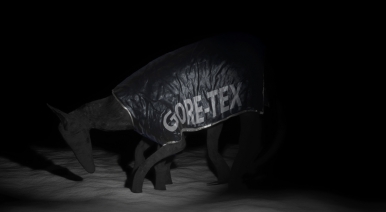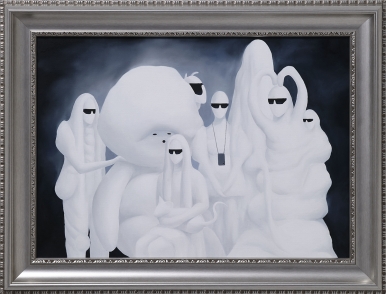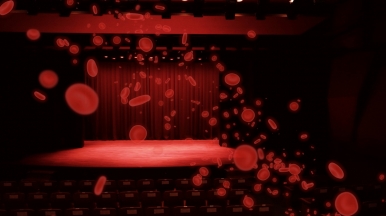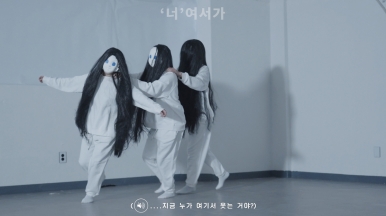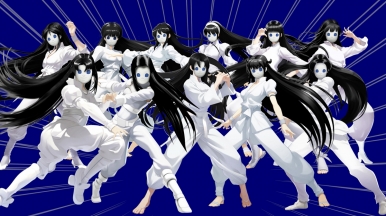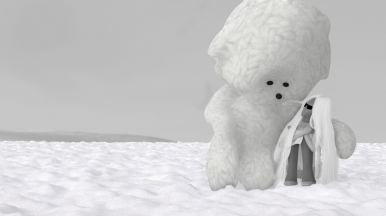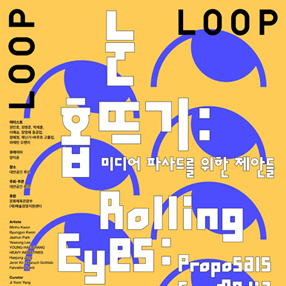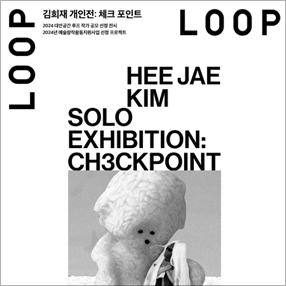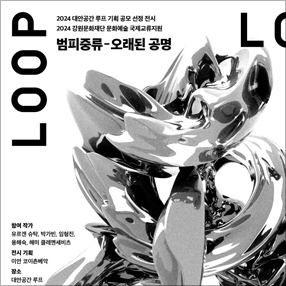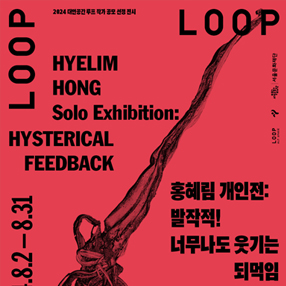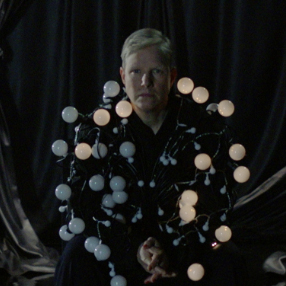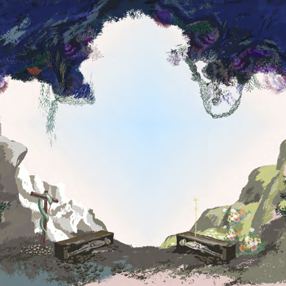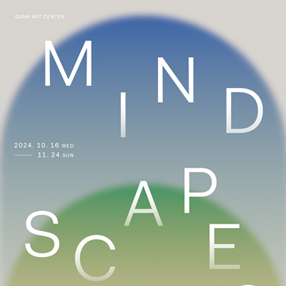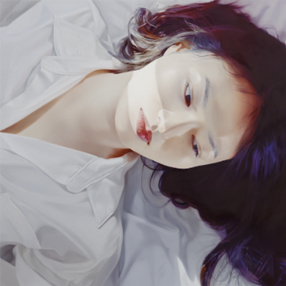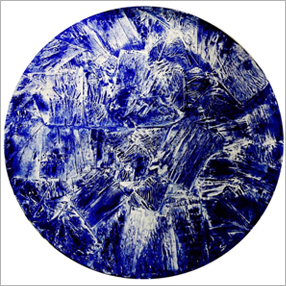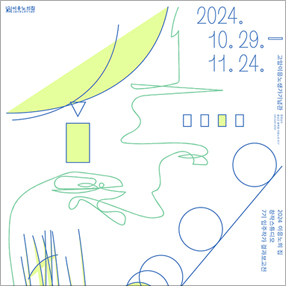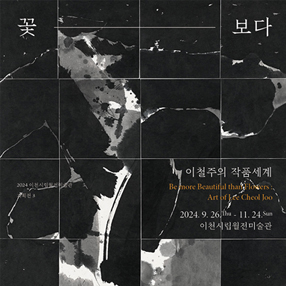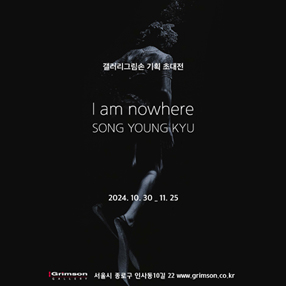본문
-
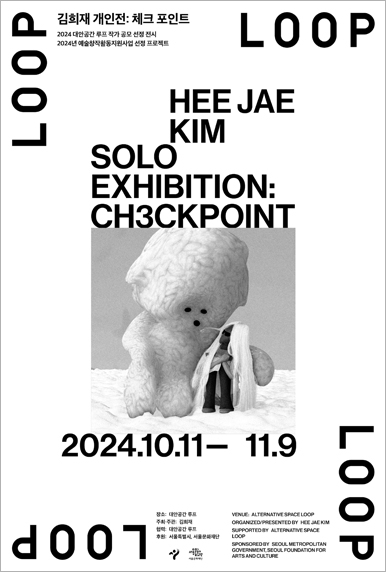
전시 포스터
-
김희재
36.5°C_3D 애니메이션 흑백, 사운드_ 각 00:01:20, 반복재생, 00:09:58(사운드)_2024
-
김희재
김-치 캔버스에 유채, 65x85cm, 2024
-
김희재
RGB 하이웨이 part1. 하울링 싱글 채널 비디오, 17분 18초, 2023
-
김희재
RGB 하이웨이 part1. 하울링 싱글 채널 비디오, 17분 18초, 2023
-
김희재
RGB 하이웨이 part2. 데스매치 싱글 채널 비디오, 16분 21초, 2023
-
김희재
RGB 하이웨이 part3. 뭉치면 주먹밥 흩어져도 볶음밥 뭐 어쨌든 맛있어 싱글 채널 비디오, 29분 42초, 2024
-
Press Release
Hee Jae Kim Solo Exhibition: CH3CKPOINT
BORN TO BE RICE
“UNITED WE ARE RICE BALLS DIVIDED WE ARE FRIED RICE ANYWAY IT’S DELICIOUS”
In Korean, we call our family members “식구” (Shik-gu), which means “people who eat together”. Explained through Chinese characters, it consists of meal/to eat (食) and mouth(口), referring to those who share meals in a family community, traditionally one organized around marriage and blood ties. In such a family, eating together is an expression of love. The breadwinner works hard to provide food for the family, while the mother strives to feed them.
In Korean culture, rice carries a meaning that goes beyond just being a meal. Just as a family is defined by eating meals together, we often reaffirm various relationships through rice. For instance, it is common to casually suggest, “Let’s have a lunch or dinner sometime” to friends encountered by chance, or offer to buy a meal for someone to whom one feels grateful. Even in times of illness, people are often reminded to eat, and mothers frequently ask if one has eaten. Rice is even offered to the deceased. In Korean culture, rice symbolizes love.
“Hee Jae Kim Solo Exhibition: CH3CKPOINT” draws an analogy between the emotions and contradictions that arise from family and interpersonal relationships, and Korean rice culture. The exhibition begins with the theme of hospitality, often expressed through the phrase, “Let’s have a lunch or dinner sometime.” This exhibition completes the artist’s trilogy project, RGB highway, which explores the emergence of alternative families and their coexistence. It also screens Part1: HOWLING, which marks the beginning of the artist’s worldview, Part2: DEATH MATCH, where these elements converge, and the new work Part3: UNITED WE ARE RICE BALLS DIVIDED WE ARE FRIED RICE ANYWAY IT’S DELICIOUS.
Hee Jae Kim has long been interested in communities. Beginning with a study of kinship-based family groups, Kim’s research has expanded to include alternative communities that transcend traditional family structures. Focusing on symbiotic relationships that cross boundaries, the artist explores new forms of family units, identities, and ways of living that continually emerge and transform without blood ties. Recent work particularly examines the ‘dual nature of hospitality’, noting how it is closely tied to the existential questions about life and death in communal living. “The dual fate of having to constantly open and close the door to others from birth to death reflects the impossibility of true coexistence,” the artist remarks.
In the new animation work, Part3: UNITED WE ARE RICE BALLS DIVIDED WE ARE FRIED RICE ANYWAY IT’S DELICIOUS, various forms of rice come to life. Anthropomorphized rice characters take the form of cute puppies that both lure and attack humans. The attacked humans then transform into rice, becoming replicated. These replicated humans throw rice at graves and turn rice into weapons like guns and arrows. Despite repeatedly gathering, scattering, replicating, and disassembling, the rice elements always reunite in the end. In the black-and-white painting kim-chi, characters from the animation nonchalantly appear. None of the characters have visible eyes. In earlier work, figures had blue eyes without pupils, while in new works, they wear sunglasses. These hollow-eyed figures inhabit a single world, seemingly concealing their emotions and remaining on guard. The film transitions between animation, manga stills, and game scenes, before concluding with real footage from the Dongjak Bridge.
Kim discusses the socially accepted meaning of love and the violence that can emerge under the guise of warmth. Is it possible to realize a way of living together based on true hospitality? In a reality filled with conflicts and sharp edges, does ‘hospitality’ truly exist, or is it merely an unattainable ideal, like a fairytale? The artist invites the other into the margins based on these questions.
Although hospitality without prejudice may be impossible, the world continues to operate through relationships disguised as hospitality. The exhibition recognizes the contradictions inherit in modern hospitality, where we face one another as strangers. It presents a worldview constructed with a science fiction imagination of what is right hospitality for our society. Viewers are invited to confront the endless cycle of ‘us’ in the artist’s world, which is wrapped in humor and wit.
Written by Sun Mi Lee, Curator of Alternative Space LOOP
(Translated by Jee Won Kim)
Hee Jae Kim
Hee Jae Kim lives and works in Berlin, working primarily with moving images. Kim’s work explores possibilities of new forms of family and community that cross boundaries, examining how individuals and communities interact and inhabit together. Kim attended the Städelschule in Frankfurt and graduated from the MFA program at the Royal College of Art. In 2023, Kim held first a solo exhibition in Korea titled at Artspace Boan1942.
김희재 개인전: 체크 포인트
본 투 비 라이스
뭉치면 주먹밥 흩어져도 볶음밥 뭐 어쨌든 맛있어
가족의 구성원을 우리는 식구라고 부른다. 한자로는 밥 식食, 입 구口. 혼인, 혈연을 중심으로 구성된 전통적인 가족 공동체에서 끼니를 함께하는 사람이다. 사랑을 기반으로 하는 가족에게 함께 밥을 먹는 행위는 그 자체로 사랑이다. 가장은 식구들의 밥을 굶기지 않기 위해, 엄마는 가족에게 밥을 먹이기 위해 애를 쓴다.
한국 문화에서 밥은 끼니 이상의 문화적 맥락을 내포하고 있다. 가족을 함께 밥을 먹는 관계로 정의하듯, 우리는 밥으로 수많은 관계를 확인한다. 우연히 만난 친구에게 언제 밥 한 끼 하자는 의례적 약속을 하고, 고마운 사람에겐 밥을 사겠다고 한다. 아플 때도 밥은 꼭 챙겨 먹으라는 당부를 하고, 엄마는 늘 밥을 먹었는지부터 묻는다. 하물며 죽은 이에게도 밥을 준다. 한국 문화에서 밥은 사랑이다.
<김희재 개인전: 체크 포인트>는 가족, 사람 사이의 관계에서 비롯된 감정과 그 안에서 발생하는 모순을 한국인의 밥 문화에 비유한다. 전시는 ‘밥 한 끼 먹자’로 통용되는 환대의 의미에서 출발한다. 대안가족의 탄생과 공존 가능성을 탐색하는 작가의 3부작 프로젝트 < RGB하이웨이 >를 완결하는 전시로, 현대사회에서 가족의 의미와 혼종을 기반으로 한 관계를 탐구한다. 작가의 세계관 시작을 알리는 < Part1: 하울링 >, 관계의 요소들이 만나기 시작하는 < Part2: 데스매치 >와 신작 < Part3: 뭉치면 주먹밥 흩어져도 볶음밥 뭐 어쨌든 맛있어 >가 함께 상영된다.
김희재는 공동체에 주목해 왔다. 혈연을 기반으로 한 가족 집단 연구를 시작으로 계보나 혈연관계에서 벗어난 대안 공동체에 대한 탐구로 확장된다. 경계를 넘나드는 공생 관계에 집중하며, 핏줄로 묶인 실체가 아닌, 끊임없이 출몰하는 새로운 형태의 가족 집단과, 정체성, 경로에 대한 프로젝트를 진행 중이다. 최근에는 ‘환대의 이중적인 성격’을 중점적으로 탐구한다. 환대의 가능성과 한계는 공동체의 일상적인 삶과 죽음이라는 실존적인 질문과 긴밀하게 연결되어 있다. 작가는 ‘탄생부터 죽음에 이르기까지 끊임없이 타자를 향해 문을 열었다 닫았다 해야 하는 이중적인 숙명은 현실적 공존의 불가능성을 나타낸다.’고 말한다.
신작 애니메이션 <뭉치면 주먹밥 흩어져도 볶음밥 뭐 어쨌든 맛있어>에는 다양한 형태의 밥이 등장한다. 캐릭터화된 밥은 귀여운 강아지의 모습으로 사람을 홀리고, 공격하고, 공격을 당한 인간은 밥의 형태가 되어 복제된다. 복제된 인간은 무덤에 밥을 던지고, 밥으로 총과 화살을 만든다. 뭉치고 흩어지고 복제되고 해체되기를 반복하며 밥으로 연결된 각각의 요소들은 ‘어쨌건’ 다시 조우한다. 흑백의 회화 작업 <김-치>에는 애니메이션에 등장하는 캐릭터들이 무심하게 모여 있다. 작가가 만들어낸 모든 캐릭터에는 눈이 보이지 않는다. 전작에서는 눈동자가 없는 파란 눈의 인물들이 등장하고, 신작의 캐릭터들은 선글라스를 쓰고 있다. 텅 빈 눈의 인물들은 경계하는 듯 감정을 감춘 채 한 세계에서 살아간다. 영상은 애니메이션, 만화 스틸컷, 게임 장면 등 판타지를 오가다 동작대교의 실사로 마무리된다.
김희재는 사회적으로 통용되는 사랑의 의미, 그 안에서 발생하는 따뜻함을 가장한 폭력에 대해 이야기한다. 진정한 환대를 바탕으로 한 공생의 방식을 실현할 수 있을까? 충돌과 칼날처럼 날카로운 상황이 지속되는 현실에서 “환대”는 과연 존재하는 것일까? 혹은 판타지 동화처럼 도달하기 어려운 이상일까? 하는 질문들을 기반으로 타자를 경계선 안으로 초대한다.
편견 없는 환대는 불가능하지만 환대로 위장한 채 관계를 맺으며 세계는 돌아간다. 전시는 이방인으로서 서로를 마주하게 되는 현대사회에서 환대의 모순을 인식하고 우리 사회에 올바른 환대는 무엇일지 SF적인 상상력으로 건설된 세계관을 소개한다. 유머와 위트로 포장된 작가의 세계에 끊임없이 순환되는 ‘우리’를 직면하기를 기대한다.
글: 이선미, 대안공간 루프 큐레이터
김희재
김희재는 현재 베를린에 거주하며 작업한다. 영상 작업을 통해 하고 싶은 이야기들을 풀어내고 있다. 주로 개인과 공동체가 어떻게 상호작용하고 함께 살아가는지에 대한 질문을 통해 경계를 넘나드는 새로운 가족과 공동체의 가능성을 탐구한다. 김희재는 프랑크프루트 슈테델슐레에서 3학기 과정을 참여했으며, 영국왕립예술학교에서 석사과정을 졸업했다. 2023년에 보안여관에서 < RGB 하이웨이 >라는 제목으로 국내 첫 개인전을 가졌다.전시제목김희재 : 체크 포인트
전시기간2024.10.11(금) - 2024.11.09(토)
참여작가 김희재
관람시간10:00am - 07:00pm
휴관일일,월요일 휴관
장르회화, 영상
관람료무료
장소대안공간 루프 ALTERNATIVE SPACE LOOP (서울 마포구 서교동 335-11 )
주최김희재
주관김희재
후원서울특별시, 서울문화재단 / 협력: 대안공간 루프
연락처02-3141-1377
-
Artists in This Show
대안공간 루프(ALTERNATIVE SPACE LOOP) Shows on Mu:umView All
Current Shows
-
폴린 부드리/레나테 로렌츠: 초상
리움미술관
2024.07.18 ~ 2024.11.24
-
예술, 보이지 않는 것들의 관문
서울대학교미술관
2024.09.12 ~ 2024.11.24
-
Mindscapes
가나아트센터
2024.10.16 ~ 2024.11.24
-
부산 청년예술가 3인전 《응시: 세 방향의 시선》
신세계갤러리 센텀시티
2024.10.26 ~ 2024.11.24
-
송준: Blue Eclipse Episode 3
전북도립미술관 서울관
2024.11.14 ~ 2024.11.24
-
Wherever : 순간이 새겨진 곳
이응노의 집
2024.10.29 ~ 2024.11.24
-
꽃 보다: 이철주의 작품세계
이천시립월전미술관
2024.09.26 ~ 2024.11.24
-
송영규: I am nowhere
갤러리 그림손
2024.10.30 ~ 2024.11.25




